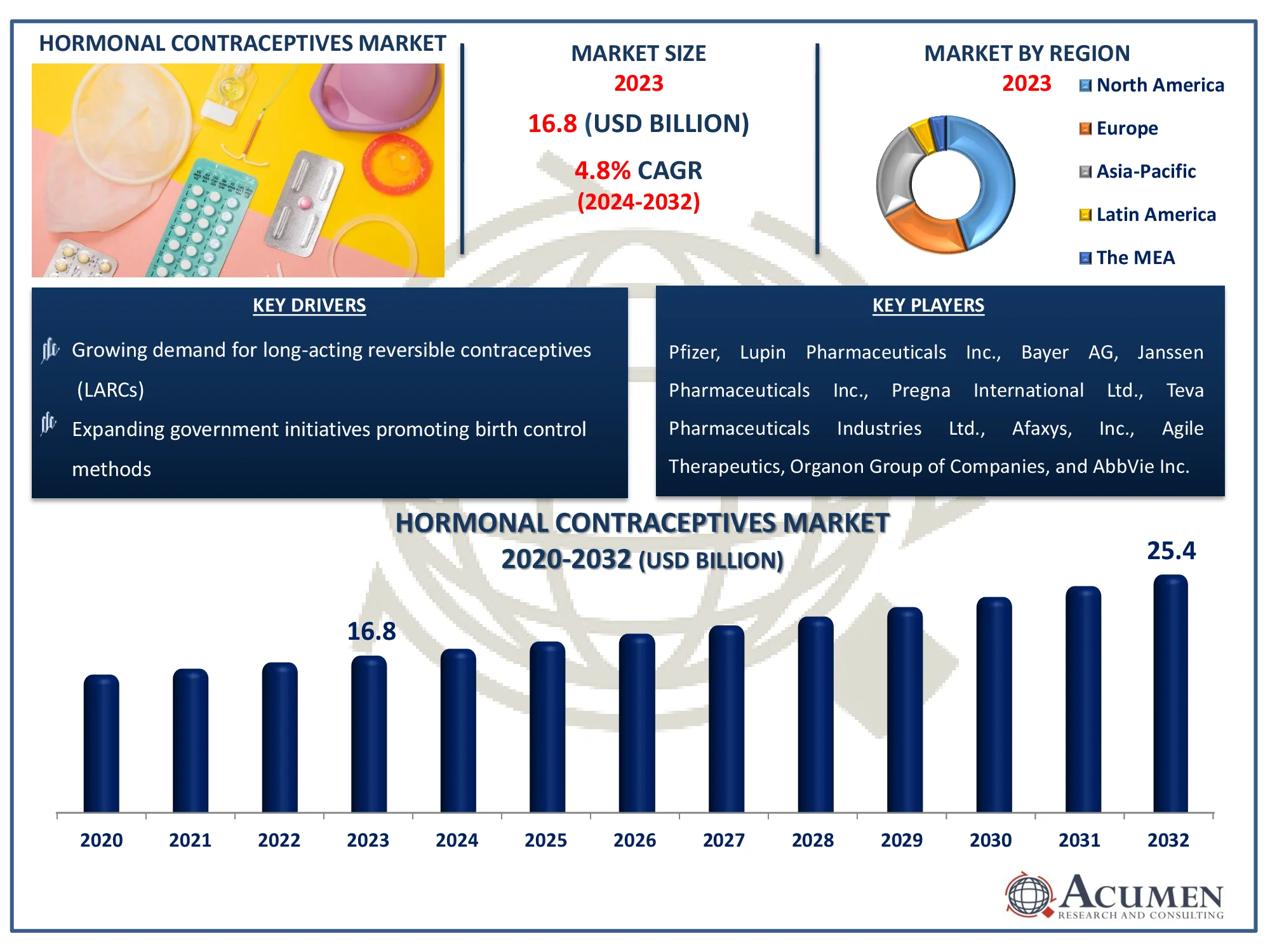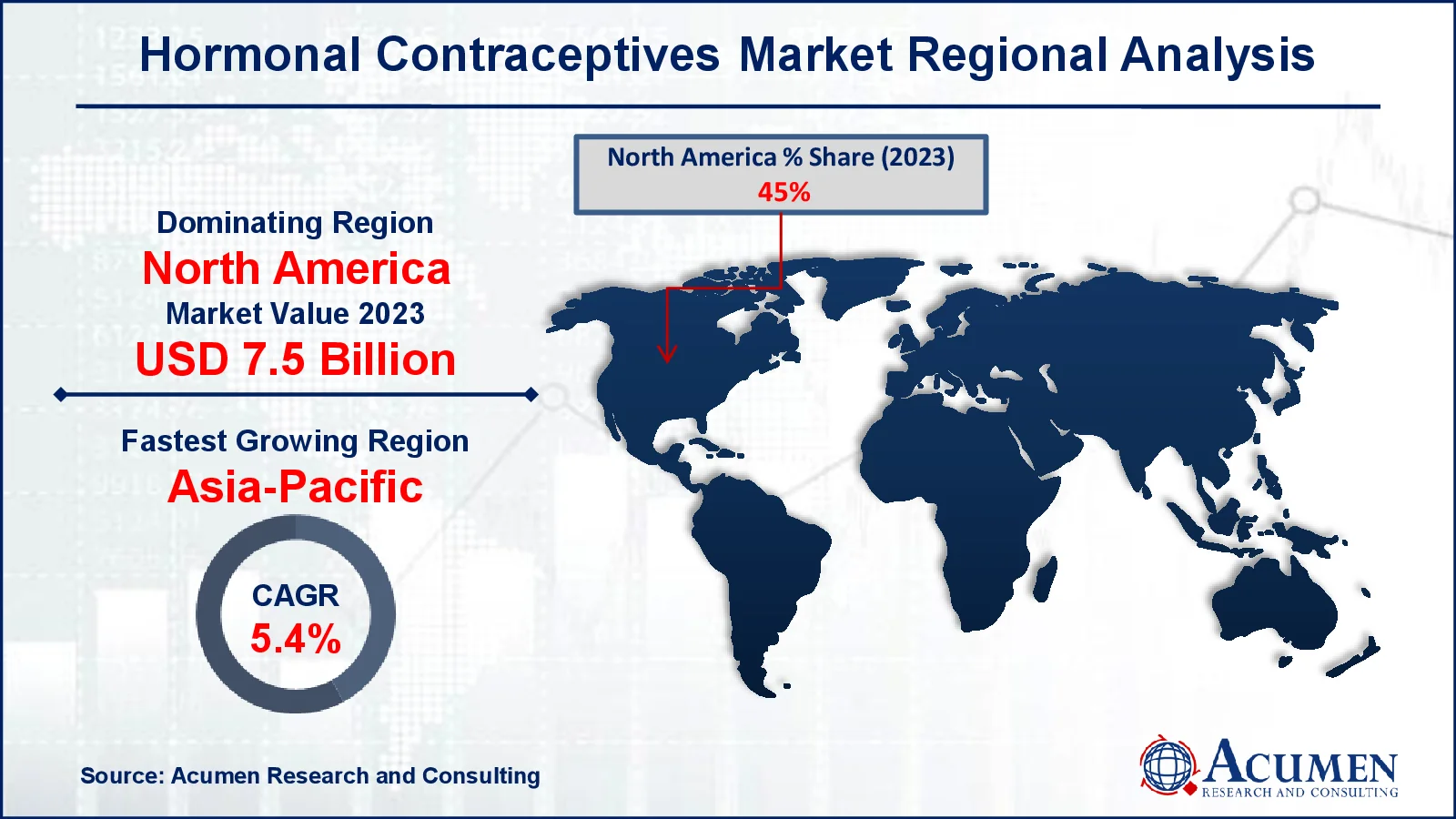June 2021
The Global Hormonal Contraceptives Market Size accounted for USD 16.8 Billion in 2023 and is estimated to achieve a market size of USD 25.4 Billion by 2032 growing at a CAGR of 4.8% from 2024 to 2032.
The Global Hormonal Contraceptives Market Size accounted for USD 16.8 Billion in 2023 and is estimated to achieve a market size of USD 25.4 Billion by 2032 growing at a CAGR of 4.8% from 2024 to 2032.
Hormonal Contraceptives Market Highlights

Contraceptives may be considered a preventive medicine or device. Contraceptives can be hormonal and non-hormonal in different kinds. The form of contraceptive in the endocrine system to regulate birth is hormonal contraceptive. The hormonal contraception regulates hormonal changes in the menstrual cycle of the female through the use of various hormones similar to progesterone and estrogen. As the incidence of issues in women's health such as PCOS, delayed child-bearing and increasing public awareness of population control increases, the demand for hormonal contraceptives rises. As a result of increasing technological progresses, a high prevalence of obesity, and an increase in PCOS worldwide, the global hormonal contraceptives market has seen a relatively strong growth.
Different kinds of hormone contraception techniques, including oral pill, skin patch, intrauterine device (IUD), injection and implantation of rod under the skin are now accessible on the market. The hormonal exposure is determined whether it is constant or intermittent, depending on the form of hormonal contraception. The prevention of implanting fertilized egg in women's wombs (uterus) begins with all hormonal contraception methods and starts developing or preventing sperm and egg from fertilizing. New and enhanced hormonal contraception techniques are being created as, under multiple conditions, the efficacy of several techniques may vary.
Global Hormonal Contraceptives Market Dynamics
Market Drivers
Market Restraints
Market Opportunities
Hormonal Contraceptives Market Report Coverage
|
Market |
Hormonal Contraceptives Market |
|
Hormonal Contraceptives Market Size 2023 |
USD 16.8 Billion |
|
Hormonal Contraceptives Market Forecast 2032 |
USD 25.4 Billion |
|
Hormonal Contraceptives Market CAGR During 2024 - 2032 |
4.8% |
|
Hormonal Contraceptives Market Analysis Period |
2020 - 2032 |
|
Hormonal Contraceptives Market Base Year |
2023 |
|
Hormonal Contraceptives Market Forecast Data |
2024 - 2032 |
|
Segments Covered |
By Product Type, By Hormone, By Age Group, By End User, and By Geography |
|
Regional Scope |
North America, Europe, Asia Pacific, Latin America, and Middle East & Africa |
|
Key Companies Profiled |
Pfizer, Lupin Pharmaceuticals Inc., Bayer AG, Janssen Pharmaceuticals Inc., Pregna International Ltd., Teva Pharmaceuticals Industries Ltd., Afaxys, Inc., Agile Therapeutics, Organon Group of Companies, and AbbVie Inc. |
|
Report Coverage |
Market Trends, Drivers, Restraints, Competitive Analysis, Player Profiling, Covid-19 Analysis, Regulation Analysis |
Hormonal Contraceptives Market Insights
The main drivers that accelerate growth are increasing awareness of contraception methods in emerging economies, investments from key players in the creation of innovative equipment and governmental initiatives to enhance access to products. The worldwide industry will grow during the hormonal contraceptives market forecast period on a constant CAGR.
A significant factor which is supposed to drive the market during the forecast period is the increase in the global infertility rate. Additionally, the international market is anticipated to increase other factors such as increased lifestyles, elevated incidence of PCOS, obesity and late childbirth owing to economic stability. In addition, awareness of population control in developed nations and numerous family planning public programs in several developing nations are additional significant considerations to boost the worldwide hormone contraceptive market.
Worldwide, women are commonly used in hormonal contraception. Hormonal contraception is adopted for birth control owing to the community's knowledge in making accurate choices on reproductive and sexual health. Increases in women's global population, urbanization and increased awareness of hormone contraception and encourages NGOs and governments to promote hormone contraception are the driving force behind the growth of the hormones market. Instead of continuous contraception, implementation of temporary and low price contraceptive practices is the key driving force of the worldwide hormonal contraception industry. Furthermore, the increase in public awareness of population control in various developed and developing countries drives this market's growth.
Governments and market players' awareness programs assist increase demand and, consequently, the contraceptives market. The progress in hormonal contraception is anticipated to further increase market growth with increased effectiveness and less side impact. In addition, health problems connected with teenage pregnancies, awareness of advanced techniques of contraception and an increasing application of oral pills to discourage unplanned pregnancy contribute to market development. Partnerships and research and development collaborations and fresh products' commercialization are main strategy for increasing their market share taken by important players.
Hormonal Contraceptives Market Segmentation
The worldwide market for hormonal contraceptives is split based on product type, hormone, age group, end user, and geography.
Hormonal Contraceptive Market By Product Type
According to hormonal contraceptives industry analysis, the prevalence of oral contraceptive pills is expected to remain stable over the predicted period. The segment's growth may be attributed to an easy and simple management mode, easy access to a wide selection of products, a high level of awareness about early-entry market tablets, and high effectiveness in terms of timely use, which is around 99 percent when compared to long-acting appliances. Furthermore, the presence and increasing penetration of numerous significant players in the area in emerging markets would help to drive segment growth.
Hormonal Contraceptive Market By Hormones
The combined hormonal contraceptive (CHC) segment leads the hormonal contraceptives market due to its widespread use and great efficacy in preventing pregnancy. CHCs combine estrogen and progestin and can be administered in a variety of ways, including tablets, patches, and vaginal rings. Their dual-hormone action inhibits ovulation, thickens cervical mucus, and changes the uterine lining, making them extremely efficient. Women prefer CHCs for their additional health benefits, including as less menstrual discomfort and more consistent cycles. The segment's expansion is also fueled by widespread availability, professional recommendations, and increased knowledge of family planning.
Hormonal Contraceptive Market By Age Group
The progestin-only contraceptive category is predicted to represent a sizable percentage of the hormonal contraceptives market. These contraceptives, which are available in the form of pills, injections, implants, and intrauterine devices (IUDs), are gaining popularity among women who are unable to use estrogen due to medical conditions such as blood clots or hypertension. Progestin-only treatments are especially popular among breastfeeding women and those looking for hormone choices with fewer adverse effects. Their rising usage is being driven by improved awareness of safer contraceptive options, expanded healthcare access, and the growing trend toward long-acting reversible contraception (LARC), all of which are expected to contribute to the segment's market growth.
Hormonal Contraceptive Market By End Users
The household segment is expected to the large percentage of the hormonal contraceptives market. With the rising availability of over-the-counter contraceptives and the growing popularity of telemedicine, more people are resorting to home-based contraception options. Many women prefer to handle their contraceptive needs privately, without making frequent visits to healthcare facilities. This transition is assisted by a greater understanding and availability of contraception, making it easier to get and use at home. As digital healthcare expands and self-administration becomes more common, the household segment is poised for major market growth.
Hormonal Contraceptives Market Regional Outlook
North America
Europe
Asia-Pacific
Latin America
The Middle East & Africa

Hormonal Contraceptives Market Regional Analysis
In 2023, North America is the dominating hormonal contraceptives market and is anticipated to remain in the forecast period. This is due to elevated per capita incomes, elevated market presence, better understanding of sexual health and a wide variety of unintentional pregnancies. Obesity, high population awareness, infertility prevalence and PCOS in the region are the key drivers for market stimulus in North America.
In the predicted era, Asia-Pacific is expected to see most rapid development. The significant variables complementing regional development include a large fertile population, the launch of fresh female contraception devices, the increase in market players' investment and powerful economical development. Countries like China, India and Japan provide significant market opportunities because of population growth, increased lifestyle-related disease prevalence, increased infertility, PCOSs and family planning government programs.
Hormonal Contraceptives Market Players
Some of the top hormonal contraceptives companies offered in our report includes Pfizer, Lupin Pharmaceuticals Inc., Bayer AG, Janssen Pharmaceuticals Inc., Pregna International Ltd., Teva Pharmaceuticals Industries Ltd., Afaxys, Inc., Agile Therapeutics, Organon Group of Companies, and AbbVie Inc.
Looking for discounts, bulk pricing, or custom solutions? Contact us today at sales@acumenresearchandconsulting.com
June 2021
February 2023
June 2022
November 2020